Living in a dense urban environment brings many startup-fuelled conveniences, be it near instant delivery of food — or pretty much whatever else you fancy — to a whole range of wheels that can be hopped on (or into) to whisk you around at the tap of an app.
But the biggest problem afflicting city dwellers is not some minor inconvenience. It’s bad, poor, terrible, horrible, unhealthy air. And there’s no app to fix that.
Nor can hardware solve this problem. But smart hardware can at least help.
For about a month I’ve been road-testing a wi-fi connected air purifier made by Swedish company, Blueair. It uses an Hepa filtration system combined with integrated air quality sensors to provide real-time in-app feedback which can be reassuring or alert you to unseen problems.
Flip to the bottom of this article for a speed take or continue reading for the full review of the Blueair Classic 480i with dual filters to reduce dust, smoke and pollen
Review
If you’re even vaguely environmentally aware it’s fascinating and not a little horrifying to see how variable the air quality is inside your home. Everyday stuff like cooking, cleaning and changing the sheets can cause drastic swings in PM 2.5 and tVOC levels. Aka very small particles such as fine dust, smoke, odours and mite feces; and total volatile organic compounds, which refers to hundreds of different gases emitted by certain solids and liquids — including stuff humans breathe out by also harmful VOCs like formaldehyde.
What you learn from smart hardware can be not just informative but instructive. For instance I’ve switched to a less dusty cat litter after seeing how quickly the machine’s fan stepped up a gear after clearing the litter tray. I also have a new depth of understanding of quite how much pollution finds its way into my apartment when the upstairs neighbour is having a rooftop BBQ. Which makes it doubly offensive I wasn’t invited.
Though, I must admit, I’ve yet to figure out a diplomatic way to convince him to rethink his regular cook-out sessions. Again, some problems can’t be fixed by apps. Meanwhile city life means we’re all, to a greater or lesser degree, adding to the collectively polluted atmosphere. Changing that requires new politics.
You cannot hermetically seal your home against outdoor air pollution. It wouldn’t make for a healthy environment either. Indoor spaces must be properly ventilated. Adequate ventilation is also of course necessary to control moisture levels to prevent other nasty issues like mould. And using this device I’ve watched as opening a window almost instantly reduced tVOC levels.
Pretty much every city resident is affected by air pollution, to some degree. And it’s a heck of a lot harder to switch your home than change your brand of cat litter. But even on that far less fixable front, having an air quality sensor indoors can be really useful — to help you figure out the best (and worst) times to air out the house. I certainly won’t be opening the balcony doors on a busy Saturday afternoon any time soon, for example.
Blueair sells a range of air purifiers. The model I’ve been testing, the Blueair Classic 480i, is large enough to filter a room of up to 40m2. It includes filters capable of filtering both particulate matter and traffic fumes (aka its “SmokeStop” filter). The latter was important for me, given I live near a pretty busy road. But the model can be bought with just a particle filter if you prefer. The dual filtration model I’m testing is priced at €725 for EU buyers.
Point number one is that if you’re serious about improving indoor air quality the size of an air purifier really does matter. You need a device with a fan that’s powerful enough to cycle all the air in the room in a reasonable timeframe. (Blueair promises five air changes per hour for this model, per the correct room size).
So while smaller air filter devices might look cute, if a desktop is all the space you can stretch to you’d probably be better off getting a few pot plants.
Blueair’s hardware also has software in the mix too, of course. The companion Blueair Friend app serves up the real-time feedback on both indoor air quality and out. The latter via a third party service whose provider can vary depending on your location. Where I live in Europe it’s powered by BreezoMeter.
This is a handy addition for getting the bigger picture. If you find you have stubbornly bad air quality levels indoors and really can’t figure out why, most often a quick tab switch will confirm local pollution levels are indeed awful right now. It’s likely not just you but the whole neighbourhood suffering.
Dirty cities
From Asia to America the burning of fossil fuels has consequences for air quality and health that are usually especially pronounced in dense urban environments where humans increasingly live. More than half the world’s population now lives in urban areas — with the UN predicting this will grow to around 70% by 2050.
In Europe, this is already true for more than 70% of the population which makes air pollution a major concern in many regional cities.
Growing awareness of the problem is beginning to lead to policy interventions — such as London’s ultra low emission charging zone and car free Sundays one day a month in Paris’ city center. But EU citizens are still, all too often, stuck sucking in unhealthy air.
Last year six EU nations, including the UK, France and Germany, were referred to the highest court in Europe for failing to tackle air pollution — including illegally high levels of nitrogen dioxide produced by diesel-powered vehicles.
Around one in eight EU citizens who live in an urban area is exposed to air pollutant levels that exceed one or more of the region’s air quality standards, according to a briefing note published by the European Environment Agency (EEA) last year.
It also said up to 96% of EU urban citizens are exposed to levels of one or more air pollutants deemed damaging to health when measured against the World Health Organization’s more stringent guidelines.
There are multiple and sometimes interlinked factors impacting air quality in urban environments. Traffic fumes is a very big one. But changes in meteorological conditions due to climate change are also expected to increase certain concentrations of air pollutants. While emissions from wildfires is another problem exacerbated by drought conditions which are linked to climate change that can also degrade air quality in nearby cities.
Action to tackle climate change continues to lag far behind what’s needed to put a check on global warming. Even as far too little is still being done in most urban regions to reduce vehicular emissions at a local level.
In short, this problem isn’t going away anytime soon — and all too often air quality is still getting worse.
At the same time health risks from air pollution are omnipresent and can be especially dangerous for children. A landmark global study of the impact of traffic fumes on childhood asthma, published recently in the Lancet, estimates that four million children develop the condition every year primarily as a result of nitrogen dioxide air pollution emitted by vehicles.
The majority (64%) of these new cases were found to occur in urban centres — increasing to 90% when factoring in surrounding suburban areas.
The study also found that damage caused by air pollution is not limited to the most highly polluted cities in China and India. “Many high-income countries have high NO2 exposures, especially those in North America, western Europe, and Asia Pacific,” it notes.
The long and short of all this is that cities the world over are going to need to get radically great at managing air quality — especially traffic emissions — and fast. But, in the meanwhile, city dwellers who can’t or don’t want to quit the bright lights are stuck breathing dirty air. So it’s easy to imagine consumer demand growing for in-home devices that can sense and filter pollutants as urbanities try to find ways to balance living in a city with reducing their exposure to the bad stuff.
Cleaner air
That’s not to say that any commercial air purifier will be able to provide a complete fix. The overarching problem of air pollution is far too big and bad for that. A true fix would demand radical policy interventions, such as removing all polluting vehicles from urban living spaces. (And there’s precious little sign of anything so radical on the horizon.)
But at least at an individual home level, a large air purifier with decent filtration technology should reduce your exposure to pollution in the place you likely spend the most time.
If, as the Blueair Classic 480i model does, the filtration device also includes embedded sensors to give real-time feedback on air quality it can further help you manage pollution risk — by providing data so you can better understand the risks in and around your home and make better decisions about, for instance, when to open a window.
“Air quality does always change,” admits Blueair’s chief product officer, Jonas Holst, when we chat. “We cannot promise to our consumers that you will always have super, super, clean air. But we can promise to consumers that you will always have a lot cleaner air by having our product — because it depends on what happens around you. In the outdoor, by your neighbours, if you’re cooking, what your cat does or something. All of those things impact air quality.
“But by having high speeds, thanks to the HepaSilent technology that we use, we can make sure that we always constantly fight that bombardment of pollutants.”
On the technology front, Blueair is using established filtration technology — Hepa and active carbon filters to remove particular matter and gaseous pollutants — but with an ionizing twist (which it brands ‘HepaSilent’).
This involves applying mechanical and electrostatic filtration in combination to enhance performance of the air purifier without boosting noise levels or requiring large amounts of energy to run. Holst dubs it one of the “core strengths” of the Blueair product line.
“Mechanical filtration just means a filter [plus a fan to draw the air through it]. We have a filter but by using the ionization chamber we have inside the product we can boost the performance of the filter without making it very, very dense. And by doing that we can let more air through the product and simply then clean more air faster,” he explains.
“It’s also something that is constantly being developed,” he adds of the firm’s Hepa + ionizing technology, which it’s been developing in its products for some 20 years. “We have had many developments of this technology since but the base technical structure is there in the combination between a mechanical and electrostatical filtration. That is what allows us to have less noise and less energy because the fan doesn’t work as hard.”
On top of that, in the model I’m testing, Blueair has embedded air quality sensors — which connect via wi-fi to the companion app where the curious user can see real-time plots of things like PM 2.5 and tVOC levels, and start to join the dots between what’s going on in their home and what the machine is sniffing out.
The sensors mean the unit can step up and down the fan speed and filtration level automatically in response to pollution spikes (you can choose it to trigger on particulate matter only, or PM 2.5 and tVOC gaseous compounds, or turn automation off altogether). So if you’re really not at all curious that’s okay too. You can just plug it in, hook it to the wi-fi and let it work.
Sound, energy and sensing smarts in a big package
To give a ballpark of energy consumption for this model, Holst says the Blueair Classic 480i consumes “approximately” the same amount of energy as running a lightbulb — assuming it’s running mostly on lower fan speeds.
[gallery ids="1832416,1832420,1832418,1832422,1832423"]
As and when the fan steps up in response to a spike in levels of potential pollutants he admits it will consume “a little bit more” energy.
The official specs list the model’s energy consumption at between 15-90 watts.
On the noise front it’s extremely quiet when on the lowest fan setting. To the point of being barely noticeable. You can sleep in the same room and certainly won’t be kept awake.
You will notice when the fan switches up to the second or, especially, the third (max) speed — where it can hit 52 dB(A)). The latter’s rushing air sounds are discernible from a distance, even in another room. But you hopefully won’t be stuck listening to level 3 fan noise for too long, unless you live in a really polluted place. Or, well, unless you run into an algorithmic malfunction (more on that below).
As noted earlier, the unit’s smart sensing capabilities mean fan speed can be set to automatically adjust in response to changing pollution levels — which is obviously the most useful mode to use since you won’t need to keep checking in to see whether or not the air is clean.
You can manually override the automation and fix/switch the fan at a speed of your choice via the app. And as I found there are scenarios where an override is essential. Which we’ll get to shortly.
The unit I was testing, a model that’s around two years old, arrived with instructions to let it run for a week without unplugging so that the machine learning algorithms could configure to local conditions and offer a more accurate read on gases and particles. Holst told us that the U.S. version of the 480i is “slightly updated” — and, as such, this learning process has been eliminated. So you should be able to just plug it in and get the most accurate reads right away.
The company recommends changing the filters every six months to “ensure performance”, or more if you live in a very polluted area. The companion app tracks days (estimated) remaining running time in the form of a days left countdown.
Looks wise, there’s no getting around the Blueair Classic 480i is a big device. Think ‘bedside table’ big.
You’re not going to miss it in your room and it does need a bigger footprint of free space around it so as not to block the air intake and outlet. Something in the region of ~80x60cm. Its lozenge shape helps by ensuring no awkward corners and with finding somewhere it can be parked parallel but not too close to a wall.
There’s not much more to say about the design of this particular model except that it’s thoughtful. The unit has a minimalist look which avoids coming across too much like a piece of ugly office furniture. While its white and gun metal grey hues plus curved flanks help it blend into the background. I haven’t found it to be an eyesore.
A neat flip up lid hides a set of basic physical controls. But once you’ve done the wi-fi set-up and linked it to the companion app you may never need to use these buttons as everything can be controlled in the app.
Real-time pollution levels at your fingertips
Warning: This app can be addictive! For weeks after installing the unit it was almost impossible to resist constantly checking the pollution levels. Mostly because it was fascinating to watch how domestic activity could send one or other level spiking or falling.
As well as PM 2.5 and tVOC pollutants this model tracks temperature and humidity levels. It offers day, week and monthly plots for everything it tracks.
The day view is definitely the most addictive — as it’s where you see instant changes and can try to understand what’s triggering what. So you can literally join the dots between, for example, hearing a street sweeper below your window and watching a rise in PM 2.5 levels in the app right after. Erk!
Though don’t expect a more detailed breakdown of the two pollutant categories; it’s an aggregated mix in both cases. (And some of the gases that make up the tVOC mix aren’t harmful.)
The month tab gives a longer overview which can be handy to spot regular pollution patterns (though the view is a little cramped on less phablet-y smartphone screens).
While week view offers a more recent snapshot if you’re trying to get a sense of your average pollution exposure over a shorter time frame.
That was one feature I thought the app could have calculated for you. But, equally, more granular quantification might risk over-egging the pudding. It would also risk being mislead if the sensor accuracy fails on you. The overarching problem with pollution exposure is that, sadly, there’s only so much an individual can do to reduce it. So it probably makes sense not to calculate your pollution exposure score.
The app could certainly provide more detail than it does but Holst told us the aim is to offer enough info to people who are interested without it being overwhelming. He also said many customers just want to plug it in and let it work, not be checking out daily charts. (Though if you’re geeky you will of course want the data.)
It’s clear there is lots of simplification going, as you’d expect with this being a consumer device, not a scientific instrument. I found the Blueair app satisfied my surface curiosity while seeing ways its utility could be extended with more features. But in the end I get that it’s designed to be an air-suck, not a time-suck, so I do think they’ve got the balance there pretty much right.
There are enough real-time signals to be able to link specific activities/events with changes in air quality. So you can literally watch as the tVOC level drops when you open a window. (Or rises if your neighbor is BBQing… ). And I very quickly learnt that opening a window will (usually) lower tVOC but send PM 2.5 rising — at least where I live in a dusty, polluted city. So, again, cleaner air is all you should expect.
Using the app you can try and figure out, for instance, optimal ventilation timings. I also found having the real-time info gave me a new appreciation for heavy rain — which seemed to be really great for clearing dust out of the air, frequently translating into “excellent” levels of PM 2.5 in the app for a while after.
Here are a few examples of how the sensors reacted to different events — and what the reaction suggests…
Cleaning products can temporarily spike tVOC levels:
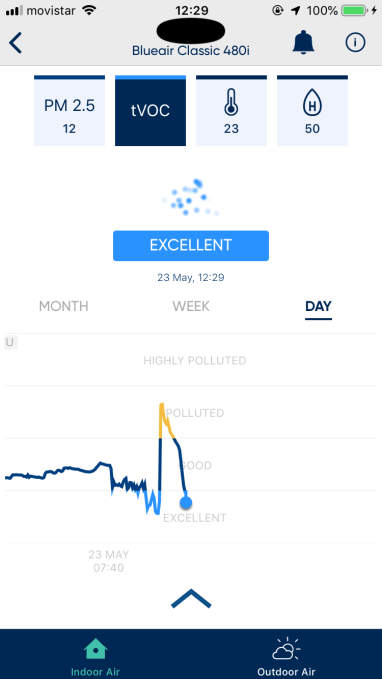
Changing bed sheets can also look pretty disturbing…
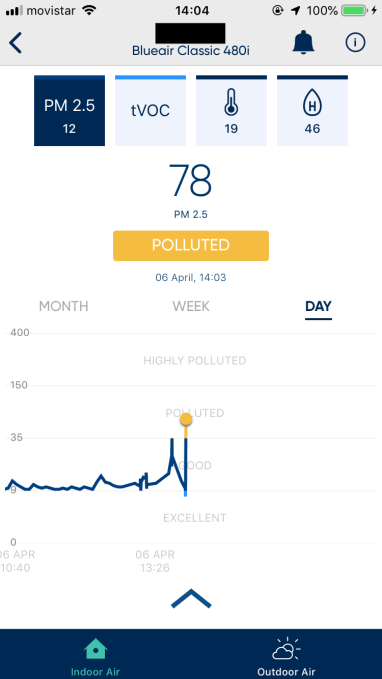
An evening BBQ on a nearby roof terrace appears much, much worse though:
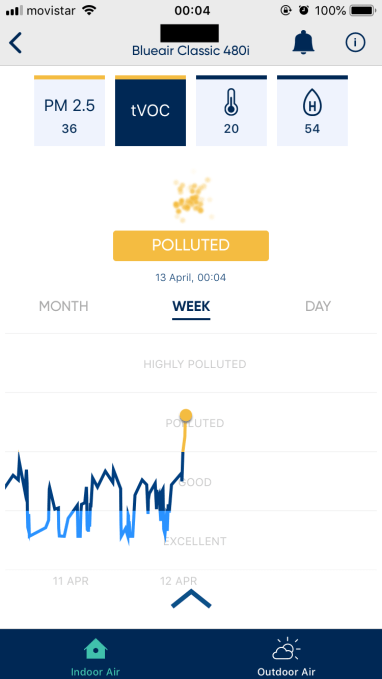
And opening the balcony door to the street on a busy Saturday afternoon is just… insane…
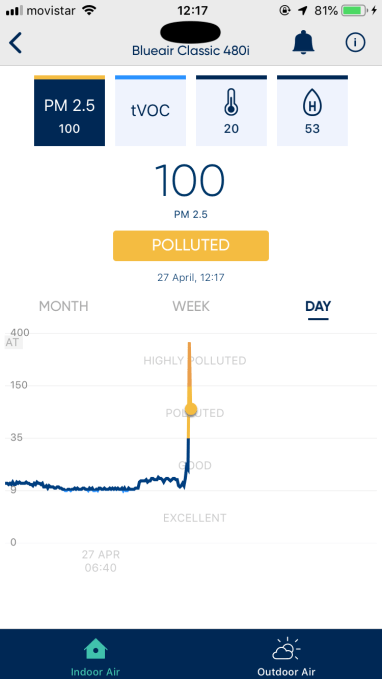
Uh-oh, algorithm malfunction…
After a few minutes of leaving the balcony door open one fateful Saturday afternoon, which almost instantly sent the unit into max fan speed overdrive, I was surprised to find the fan still blasting away an hour later, and then three hours later, and at bedtime, and in the morning. By which point I thought something really didn’t seem right.
The read from the app showed the pollution level had dropped down from the very high spike but it was still being rated as ‘polluted’ — a level which keeps the fan at the top speed. So I started to suspect something had misfired.
This is where being able to switch to manual is essential — meaning I could override the algorithm’s conviction that the air was really bad and dial the fan down to a lower setting.
That override provided a temporary ‘fix’ but the unnaturally elevated ‘pollution’ read continued for the best part of a week. This made it look like the whole sensing capacity had broken. And without the ability to automatically adapt to changing pollution levels the smart air purifier was now suddenly dumb…
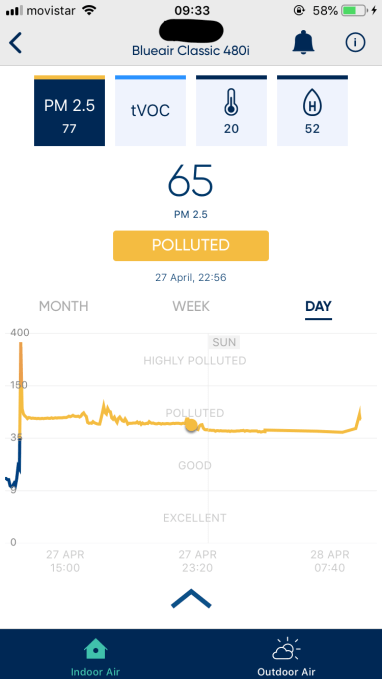
It turned out Blueair has a fix for this sort of algorithmic malfunction. Though it’s not quick.
After explaining the issue to the company, laying out my suspicion that the sensors weren’t reading correctly, it told me the algorithms are programmed to respond to this type of situation by reseting around seven days after the event, assuming the read accuracy hasn’t already corrected itself by then.
Sure enough, almost a week later that’s exactly what happened. Though I couldn’t find anything to explain this might happen in the user manual, so it would be helpful if they include it in a troubleshooting section.
Here’s the month view showing the crazy PM 2.5 spike; the elevated extended (false) reading; then the correction; followed finally by (relatively) normal service…
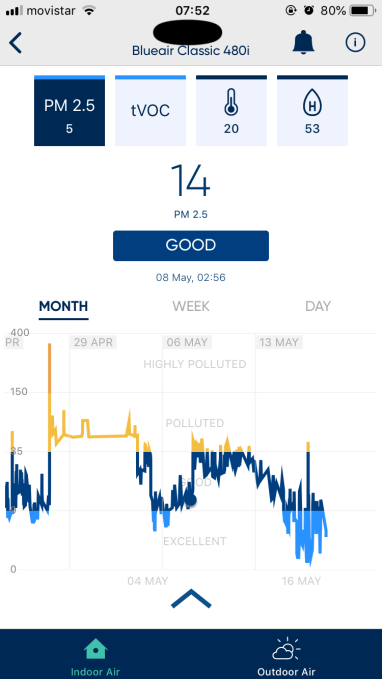
For a while after this incident the algorithms also seemed overly sensitive — and I had to step in again several times to override the top gear setting as its read on pollution levels was back into the yellow without an obvious reason why.
When the level reads ‘polluted’ it automatically triggers the highest fan speed. Paradoxically, this sometimes seems to have the self-defeating effect of appearing to draw dust up into the air — thereby keeping the PM 2.5 level elevated. So at times manually lowering the fan when it’s only slightly polluted can reduce pollution levels quicker than just letting it blast away. Which is one product niggle.
When viewed in the app the sustained elevated pollution level did look pretty obviously wrong — to the human brain at least. So, like every ‘smart’ device, this one also benefits from having human logic involved to complete the loop.
Concluding thoughts after a month’s use
A few weeks on from the first algorithm malfunction the unit’s sensing capacity at first appeared to have stabilized — in that it was back to the not-so-hair-trigger-sensitivity that had been the case prior to balcony-door-gate.
For a while it seemed less prone to have a sustained freak out over relatively minor domestic activities like lifting clean sheets out of the cupboard, as if it had clicked into a smoother operating grove. Though I remained wary of trying the full bore Saturday balcony door.
I thought this period of relative tranquility might signal improved measurement accuracy, the learning algos having been through not just an initial training cycle but a major malfunction plus correction. Though of course there was no way to be sure.
It’s possible there had also been a genuine improvement in indoor air quality — i.e. as a consequence of, for example, better ventilation habits and avoiding key pollution triggers because I now have real-time air quality feedback to act on so can be smarter about when to open windows, where to shake sheets, which type of cat litter to buy and so on.
It’s a reassuring idea. Though one that requires putting your faith in algorithms that are demonstrably far from perfect. Even when they’re functioning they’re a simplification and approximation of what’s really going on. And when they fail, well, they are clearly getting it totally wrong.
Almost bang on the month mark of testing there was suddenly another crazy high PM 2.5 spike.
One rainy afternoon the read surged from ‘good’ to ‘highly polluted’ without any real explanation. I had opened a patio on the other side of the apartment but it does not open onto a street. This time the reading stuck at 400 even with the fan going full blast. So it looked like an even more major algorithm crash…
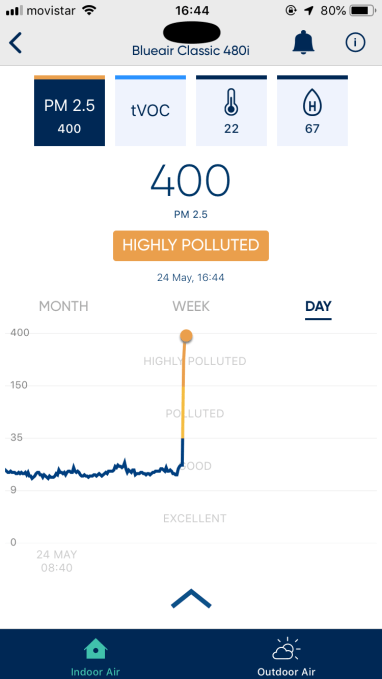
Really clean air is impossible to mistake. Take a walk in the mountains far from civilization and your lungs will thank you. But cleaner air is harder for humans to quantify. Yet, increasingly, we do need to know how clean or otherwise the stuff we’re breathing is, as more of us are packed into cities exposed to each others’ fumes — and because the harmful health impacts of pollution are increasingly clear.
Without radical policy interventions we’re fast accelerating towards a place where we could be forced to trust sensing algorithms to tell us whether what we’re breathing is harmful or not.
Machines whose algorithms are fallible and might be making rough guestimates, and/or prone to sensing malfunctions. And machines that also won’t be able to promise to make the air entirely safe to breathe. Frankly it’s pretty scary to contemplate.
So while I can’t now imagine doing without some form of in-home air purifier to help manage my urban pollution risk — I’d definitely prefer that this kind of smart hardware wasn’t necessary at all.
In Blueair’s case, the company clearly still has work to do to improve the robustness of its sensing algorithms. Operating conditions for this sort of product will obviously vary widely, so there’s loads of parameters for its algorithms to balance.
With all that stuff to juggle it just seems a bit too easy for the sensing function to spin out of control.
10-second take
The good
Easy to set up, thoughtful product design, including relatively clear in-app controls and content which lets you understand pollution triggers to manage risk. Embedded air quality sensors greatly extend the product’s utility by enabling autonomous response to changes in pollution levels. Quiet operation during regular conditions. Choice of automated or manual fan speed settings. Filtration is powerful and since using the device indoor air quality does seem cleaner.
The bad
Sensing accuracy is not always reliable. The algorithms appear prone to being confused by air pressure changes indoors, such as a large window being opened which can trigger unbelievably high pollution readings that lead to an extended period of inaccurate readings when you can’t rely on the automation to work at all. I also found the feedback in the app can sometimes lag. App content/features are on the minimalist side so you may want more detail. When the pollution level is marginal an elevated fan speed can sometimes appear to challenge the efficacy of the filtration as if it’s holding pollution levels in place rather than reducing them.
Bottom line
If you’re looking for a smart air purifier the Blueair Classic 480i does have a lot to recommend it. Quiet operation, ease of use and a tangible improvement in air quality, thanks to powerful filtration. However the accuracy of the sensing algorithms does pose a dilemma. For me this problem has recurred twice in a month. That’s clearly not ideal when it takes a full week to reset. If it were not for this reliability issue I would not hesitate to recommend the product, as — when not going crazy — the real-time feedback it provides really helps you manage a variety of pollution risks in and around your home. Hopefully the company will work on improving the stability of the algorithms. Or at least offer an option in the app so you can manually reset it if/when it does go wrong.
from TechCrunch https://tcrn.ch/2Qp0rDG
No comments:
Post a Comment